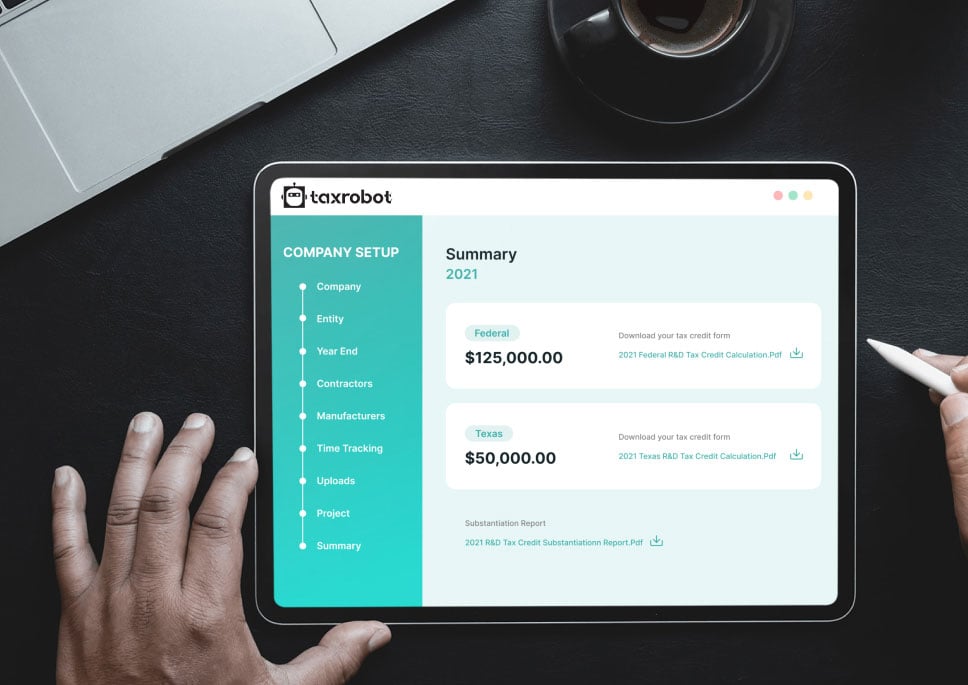Colorado R&D Credit
Get started with TaxRobot to maximize your Colorado R&D tax credit.
Maximize your State Credits today!
Put the R&D tax credit process on autopilot.
Trusted By:








Colorado R&D Credit
Discover your eligibility for Colorado R&D tax credits and supercharge your enterprise.
Are There R&D Tax Credits in Colorado?
Yes, Colorado offers tax credits specifically designed to compensate for and encourage research and development activities. However, these tax credits are only offered to companies based within one of the state’s Enterprise Zones.
This tax credit must be filed alongside Colorado tax returns and are due at the same time. However, pre-certification with the Enterprise Zone administrator is necessary beforehand.
Federal R&D Tax Credit
The Colorado R&D tax credit exists alongside the federal R&D tax credit. In most cases, companies are eligible for both at the same time. So, companies can (and should) apply for both at once.
Does Your Business Qualify?
First off, a business must be located within a Colorado Enterprise Zone in order to be eligible. Then, that business must pre-certify with their local enterprise zone administrator to verify and maintain their eligibility. This involves submitting forms DR 0074, DR 0076, or DR 0077 to the local administrator.
Businesses also must fall into one of several categories to qualify. These include:
- C-Corporation
- S-Corporations
- LLCs
- Partnerships
Qualified Research
Not all research and development activities are eligible for this credit. Following along with a research and experimentation tax credit guide helps determine what is eligible and what is not. Activities eligible for the Colorado R&D tax credit must fall under a few specific categories. Specifically, they need to:
- Be technological in nature
- Be useful for developing a new or improved product or component of the business
- Use experimentation
These expenses can come from many different places. These include:
- Employee wages
- Supplies used in the process
- Payments for using computers
- Expenses incurred to pay for a third party to conduct contract research within an enterprise zone.
How Much Is the Colorado R&D Credit?
The Colorado R&D tax credit is calculated based on the increase in the amount of a business’s research and experimental expenses when compared to the average of the previous two years. 3% of this amount is eligible for a tax credit.
However, each year, the business is only able to claim 25% of the total credit. This can be claimed alongside carryover from the past. The rest of the credit is carried forward into the future, with the possibility to claim another 25% each year. So, the entire credit ends up being paid out over the course of 4 years.
Important Notes to Remember
The Colorado R&D tax credit is unique because it carries forward. If a company’s tax liability ends up being less than the tax credit, it can carry forward the unused amount for the future. This can be done without limit.
The credit is available for new businesses as well as existing businesses. New businesses will need to calculate their credit differently and may be subject to a prorated amount, but they can still apply.
The business needs to be legal under federal law as well as state law. So, this would exclude companies in the marijuana industry from being able to apply for this credit.
Optimize Your Colorado R&D Credit With TaxRobot
With any tax credit, you want to maximize the amount you get. Otherwise, you are just leaving money on the table. However, you don’t want to mess up the process and end up claiming too much. In this case, it could lead to trouble. So, walking this tightrope can definitely be tricky.
Luckily, TaxRobot is here to help. We offer tax credit software and tax credit consulting that can help you navigate this delicate situation. We’ll make sure that your application follows all guidelines while also making sure that you get the largest tax credit possible.
Find Out How Much You Could Save
Wondering how much of a tax credit you could expect? Use our calculator to get an estimate.
Take a sneak peak

- Limited Time Offer
- Simple Onboarding
- Easy to Use
R&D Tax Credits FAQs
The four-part test as outlined in the Internal Revenue Code is used to determine qualified R&D activity.
The Four-Part Test
1). New Or Improved Business Component
Creation of a new product, process, formula, invention, software, or technique; or improving the performance, functionality, quality, or reliability of existing business component.
- Construction of new buildings or renovation of existing buildings
- Invention of a software application
- Manufacturing of a new product or the improvement of the production process for an existing product
- Creation of design documentation
2). Technological In Nature
The activity fundamentally relies on principles of the physical or biological sciences, engineering, or computer science. A taxpayer does not need to obtain information that exceeds, expands or refines the common knowledge of skilled professionals in a particular field.
- Physics (relationship between mass, density and volume; loading as the
result of gravitational attraction) - Engineering (mechanical, electrical, civil, chemical)
- Computer science (theory of computation and design of computational systems)
3). Elimination Of Uncertainty
Uncertainty exists if the information available to the taxpayer does not establish the capability or method for developing or improving the business component, or the appropriate design of the business component.
- The capability of a manufacturer to create a part within the specified tolerances
- The appropriate method of overcoming unsuitable soil conditions during construction
- The appropriate software design to meet quality and volatility requirements
4). Process Of Experimentation
A process designed to evaluate one or more alternatives to achieve a result where the capability or method of achieving that result, or the appropriate design of that result, is uncertain as of the beginning of the taxpayer’s research activities.
- Systematic process of trial and error
- Evaluating alternative means and methods
- Computer modeling or simulation Prototyping Testing
The R&D tax credit is one of the most misunderstood tax incentives available. Considering the myriad of industries and activities that legally qualify for the credit, the term “research and development” is a misnomer. Additionally, the R&D tax credit requires specialized knowledge and technology to identify and calculate the incentive properly.
Companies of various industries are unaware that they are eligible to claim the R&D tax credit. Under the Internal Revenue Code’s definition of R&D, many common activities qualify. You can get tax benefits for industries including software, technology, architecture, engineering, construction, manufacturing, and more.
The R&D tax credit can be claimed for all open tax years. Generally, open tax years include the prior three tax years due to the statute of limitations period. In certain circumstances, the law allows businesses to claim the R&D tax credit for an extended period of time. It is common for companies to amend previous tax years to claim this benefit and reduce the maximum amount of tax liability.
Partnerships and S corporations must file this form to claim the credit. The credit will flow from the Form 6765, to the Schedule K-1, to the Form 3800 on the individual’s tax return. For individuals receiving this credit that have ownership interest in a partnership or S corporation, Form 6765 is not required on the individual return.
Individuals claiming this credit can report the credit directly on Form 3800, General Business Credit if their only source for the credit is a partnership, S corporation, estate, or trust. Otherwise, Form 6765 must be filed with the individual’s tax return (e.g. sole proprietorship).
For tax years prior to 2016, the credit can be used to reduce the taxpayer’s regular tax liability down to the tentative minimum tax. The credit cannot be used to offset alternative minimum tax. Beginning in tax year 2016, eligible small businesses have expanded utilization for the credit. For these eligible small businesses, the regular tax liability can offset alternative minimum tax using the “25/25” rule.
What our customers have to say
I highly recommend TaxRobot to anyone considering an R&D Tax Credit software to complete their analysis.

We decided to switch to TaxRobot… Best decision we’ve ever made. More affordable, and less complicated.

I couldn’t believe how easy it was! In under an hour, we saved enough money to hire a new employee.
